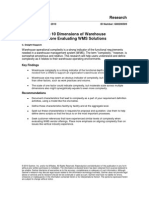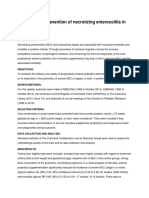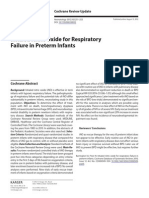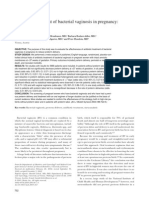0 ratings0% found this document useful (0 votes)
22 viewsMain Abr
Main Abr
Uploaded by
IndraWijayauji coba
Copyright:
© All Rights Reserved
Available Formats
Download as PDF, TXT or read online from Scribd
Main Abr
Main Abr
Uploaded by
IndraWijaya0 ratings0% found this document useful (0 votes)
22 views3 pagesuji coba
Original Title
main-abr
Copyright
© © All Rights Reserved
Available Formats
PDF, TXT or read online from Scribd
Share this document
Did you find this document useful?
Is this content inappropriate?
uji coba
Copyright:
© All Rights Reserved
Available Formats
Download as PDF, TXT or read online from Scribd
Download as pdf or txt
0 ratings0% found this document useful (0 votes)
22 views3 pagesMain Abr
Main Abr
Uploaded by
IndraWijayauji coba
Copyright:
© All Rights Reserved
Available Formats
Download as PDF, TXT or read online from Scribd
Download as pdf or txt
You are on page 1of 3
OBSTETRICS
Use of antibiotics for the treatment of preterm parturition
and prevention of neonatal morbidity: a metaanalysis
Carolyn E. Hutzal, MD; Elaine M. Boyle, MD; Sara L. Kenyon, MA; Jennifer V. Nash, BHSc;
Stephanie Winsor, MD; David J. Taylor, MD; Haresh Kirpalani, BM, MSc
BACKGROUND AND OBJECTIVE
Despite major advances inperinatal care,
preterm delivery remains the predomi-
nant cause of perinatal mortality and a
major cause of neurologic morbidity in
surviving infants. Evidence suggests that
intrauterine infection is a contributing
factor to preterm delivery.
Potential benets of delaying delivery
may be greatest for infants born before
34 weeks. Even prolongation of preg-
nancy for 48 hours may facilitate admin-
istration of antenatal maternal cortico-
steroids, reducing neonatal respiratory
disease and improving outcomes.
The aim of our review was to deter-
mine whether antibiotic treatment of 24
hours or longer prolongs pregnancy and
reduces neonatal morbidity in women
presenting in preterm labor with intact-
membranes (PTL) or preterm prema-
ture rupture of membranes (PPROM) at
22-34 weeks gestation, representing the
subgroup of infants at highest risk.
MATERIALS AND METHODS
We conducted a literature search limited
to randomized placebo-controlled trials
published between 1988 and 2006, with
no language restriction. Hand searches
of conference proceedings (1995 to
2005) were performed. Inclusion criteria
were: (1) women presenting at 22-34
weeks of gestation with PPROM or in
PTL; (2) randomized comparison of any
antibiotic therapy regimenvs placebofor
24 hours or longer; and (3) data available
for latency period.
Studies using antenatal steroids or to-
colytics were not excluded. Outcomes
were dened a priori. Separate subgroup
analyses of PPROM and PTL were per-
formed. The primary outcome was la-
tency period.
RESULTS
Of 456 citations retrieved, 416 failed to
meet inclusion criteria. Nineteen articles
included infants born at longer than 34
weeks gestation, and authors were un-
able to provide separate data for the rel-
evant infants. The remaining 21 studies
were included: 9 studies of PPROM, 10
of PTL, and 2 of both.
For PPROM, 11 studies reported av-
erage latency period as a primary out-
come. Because studies used different
measures of latency, we conducted
separate subanalyses for average la-
tency period, delivery within 48 hours,
and delivery within 7 days. There was a
signicant prolongation in time to de-
livery with antibiotic use in PPROM
across all 3 measures of latency (Fig-
ure). Seven studies reported clinically
diagnosed chorioamnionitis (CA),
which was signicantly reduced in
women receiving antibiotics. There
was a trend toward decreased histolog-
ically diagnosed CA in the treatment
group.
Maternal antibiotics did not reduce
neonatal mortality, as reportedin9 stud-
ies of PPROM. Ten studies reported the
occurrence of respiratory distress syn-
drome (RDS) or hyaline membrane dis-
ease (HMD), with no difference between
groups. In 3 studies, no statistically sig-
nicant differences were seen in rates of
bronchopulmonary dysplasia (BPD).
Nine PPROM studies reporting on all
grades of intraventricular hemorrhage
(IVH) found a statistically signicant re-
duction in any grade of IVHin infants of
mothers given antibiotics.
One study reported periventricular
leukomalacia (PVL) in infants of moth-
ers who had PPROM. No differences
were seen between treatment groups.
Neonatal sepsis conrmed by culture
was reported in 5 studies of PPROM. A
trend toward reduced infection was seen
in infants whose mothers had received
antibiotics. Clinically diagnosed neona-
tal infection was reported in 9 studies of
PPROM. Maternal antibiotic treatment
was associated with reduced neonatal
infection.
Fromthe Departments of Pediatrics (Drs
Hutzal, Boyle, and Kirpalani and Ms Nash),
Obstetrics and Gynecology (Dr Winsor),
and Clinical Epidemiology and Biostatistics
(Dr Kirpalani), Faculty of Health Sciences,
McMaster University, Hamilton, ON,
Canada; the Reproductive Sciences Section,
Department of Cancer Studies and
Molecular Medicine, University of Leicester,
Leicester, United Kingdom(Ms Kenyon and
Dr Taylor); and the Department of
Neonatology, Childrens Hospital,
University of Pennsylvania, Philadelphia, PA
(Dr Kirpalani).
Presented at the 45th Annual Meeting of the
European Society for Paediatric Research,
Stockholm, Sweden, Sept. 18-21, 2004.
Cite this article as: Hutzal CE, Boyle EM, Kenyon SL, et al.
Use of antibiotics for the treatment of preterm parturition
and prevention of neonatal morbidity: a metaanalysis.
Am J Obstet Gynecol 2008;199:620.e1-620.e8.
0002-9378/free
2008 Mosby, Inc. All rights reserved.
doi: 10.1016/j.ajog.2008.07.008
For Editors Commentary,
see Table of Contents
See related editorial, page 583
OVERVIEW
Antibiotic therapy in preterm prema-
ture rupture of membranes at a ges-
tation of 34 weeks or less reduces
rates of neonatal infection and intra-
ventricular hemorrhage, but in preterm
labor with intact membranes the ben-
ets remain unclear.
Research www.AJOG.org
620 American Journal of Obstetrics &Gynecology DECEMBER 2008
In 8 PPROMstudies reporting on nec-
rotizing enterocolitis (NEC), no differ-
ences were observed between groups.
Five studies reported length of hospital-
ization. Treatment of women with anti-
biotics was not associated with reduced
hospitalization for neonates whose
mothers had PPROM.
Women with PTL showed no signi-
cant improvement in any measure of
prolongation of pregnancy for women
given antibiotics (Figure). Regarding
secondary outcomes, in 5 trials examin-
ing clinical CA, a trend toward decreased
CA was noted with antibiotic treatment
in studies using clinical denitions. In 2
studies that used histology, a signicant
difference paralleled these ndings.
Mortality was reported in 9 studies of
PTL, with no signicant difference be-
tween groups.
Eight studies of PTL reported on RDS
or HMD. There were no signicant dif-
ferences between groups. One study of
PTL reported BPD as an outcome. Both
accepted denitions were statistically in-
signicant, whether oxygen dependency
at 36 weeks corrected gestation or at 28
postnatal days.
Six studies of PTL included any grade
of IVH. No differences were seen be-
tween randomized groups. Two studies
examined the subgroup with severe IVH
(grades III and IV). There were no
differences.
One study of PTL included PVL as an
outcome. No differences were seen be-
tween treatment groups. Regarding neo-
natal infection, culture-positive infec-
tion was reported in 2 studies of PTL;
there was no decrease in neonatal infec-
tion with antibiotic therapy. Clinical
neonatal sepsis was reported in 9 PTL
studies. Analysis showed signicantly re-
duced infection in infants of women re-
ceiving antibiotics, although signicant
heterogeneity existedbetweenstudies. In
5 studies of PTL that included necrotiz-
ing enterocolitis as an outcome, no sig-
nicant differences were seen in rates of
NEC.
Four studies reported on length of
neonatal hospitalization. Maternal anti-
biotics were associated with signicantly
reduced hospital stay in the PTL group;
however, signicant heterogeneity was
seen between studies.
A potential advantage of delaying de-
livery is the ability to enhance fetal lung
maturation by administering maternal
corticosteroids. Steroids were given to
women in 1 study (9%) of PPROM and
5 studies (42%) of PTL. Two studies did
not report steroid use.
Publication bias was evaluated with
funnel plots of the 3 outcomes of latency.
All plots appeared symmetrical for both
PPROM and PTL.
COMMENT
Our results suggest that for women with
PPROMat a gestationof 34 weeks or less,
antibiotics were benecial in delaying
delivery and in reducing CA, neonatal
infection, and IVH. However, for
women in PTL at 34 weeks or less with
intact membranes, other than a reduc-
tion in clinically diagnosed infection, ev-
idence is insufcient to recommend ad-
ministration of antibiotics. More rened
testing for PTL, such as fetal bronectin,
might improve outcomes of antibiotic
use by more appropriate patient
selection.
Our ndings broadly agree with those
of prior metaanalyses. Although our re-
view contains fewer total numbers of
studies and mother-infant dyads ran-
domized, the included sample pool re-
mains large.
The presumption of the current re-
view was that even a 24-hour window
would allow improved respiratory sta-
tus, because steroids might be coadmin-
istered. Yet we do not showbenecial ef-
fects of antibiotics on respiratory
morbidity in the PPROM group, al-
though this was seen in the Cochrane re-
FIGURE
Average Latency Period: PPROM and PTL
Study Treatment Control WMD (fixed) Weight WMD (fixed)
or sub-category N Mean (SD) N Mean (SD) 95% CI % 95% CI
01 Preterm premature rupture of membranes
Kenyon PPROM 3081 16.62(23.65) 1055 16.40(24.58) 0.94 0.22 [-1.48 to 1.92]
Matsuda 34 7.91(8.55) 41 5.01(9.54) 0.16 2.90 [-1.20 to 7.00]
McCaul: PPROM group 41 8.10(11.20) 43 17.80(27.00) 0.04 -9.70 [-18.47 to -0.93]
Ovalle 50 0.60(0.52) 50 0.27(0.30) 98.84 0.33 [0.16-0.50]
Winkler 20 34.00(26.00) 20 25.00(23.00) 0.01 9.00 [-6.21 to 24.21]
Subtotal (95% CI) 3226 1209 100.00 0.33 [0.17-0.50]
Test for heterogeneity: Chi = 7.80, df = 4 (P = .10), I = 48.7%
Test for overall effect: Z = 3.92 (P < .0001)
02 Preterm labour
Kenyon PTL 4314 44.28(28.05) 1446 44.56(27.85) 89.27 -0.28 [-1.94 to 1.38]
Keuchkerian 47 43.99(25.61) 49 45.52(30.16) 1.97 -1.53 [-12.71 to 9.65]
McCaul: PTL group 21 35.20(29.60) 19 34.70(21.10) 0.98 0.50 [-15.32 to 16.32]
McGregor PTL 53 35.30(24.10) 50 25.40(20.00) 3.38 9.90 [1.37-18.43]
Nadisauskiene 59 51.10(34.30) 51 40.60(36.40) 1.40 10.50 [-2.78 to 23.78]
Newton 1989 48 34.20(21.00) 47 34.10(24.00) 2.99 0.10 [-8.98 to 9.18]
Subtotal (95% CI) 4542 1662 100.00 0.21 [-1.36 to 1.78]
Test for heterogeneity: Chi = 7.69, df = 5 (P = .17), I = 35.0%
Test for overall effect: Z = 0.26 (P = .79)
-10 -5 0 5 10
Favors control Favors treatment
Latency period was signicantly prolonged in studies of PPROM but was not prolonged in studies of PTL.
Hutzal. Antibiotics for preterm parturition and prevention of neonatal morbidity. Am J Obstet Gynecol 2008.
www.AJOG.org Obstetrics Research
DECEMBER 2008 American Journal of Obstetrics &Gynecology 621
view by Kenyon et al that included more
mature infants.
Our study period covered eras ank-
ing the full recognition of the benets of
antenatal steroids for preterm infants,
thus accounting for the variation in their
use. Pooled effects probably underesti-
mate the potential benets of combined
use of antenatal steroids and antibiotics
for PTL. Steroid administration is now
standard care. Possibly antenatal antibi-
otics confer a greater effect on lung ion
and water transport in this group rather
than on lung surfactant system matura-
tion in the preterm.
Results of our secondary outcomes are
also similar to the Cochrane metaanaly-
ses. We found that for both PPROMand
PTL, infection-related outcomes were
probably improved. However, plausible
trends toward reduced histological CA
are seen in PTL and PPROM, supported
by a signicant reduction in clinical CA
in both groups.
Overt neonatal infection was exam-
ined with the criterion standard of cul-
ture-positive infection and the less ro-
bust outcome of clinically diagnosed
infection. For PPROM, both were re-
duced, with clinically diagnosed infec-
tion achieving statistical signicance.
For PTL, however, we found no signif-
icant reduction in culture-proven in-
fections; the nding of reduced clini-
cally diagnosed infection is vitiated by
heterogeneity.
The signicant reduction in all grades
of IVHininfants of womeninPPROMis
not surprising, because cranial ultra-
sound abnormalities are more likely at
lower gestational ages. However, there is
no signicant reduction in clinically im-
portant types of IVH or PVL.
The relative merits of different antibi-
otic regimens in PPROM and PTL and
their impact on colonization and neona-
tal outcomes require further evaluation.
The reduced incidence in several as-
pects of neonatal morbidity in the
PPROM group did not translate into
shortened neonatal hospitalization or
reduced mortality. Conversely, treat-
ment during PTL demonstrated a signif-
icant reduction in infant hospital stay
despite the lack of benecial effect on
neonatal morbidity, apart from a reduc-
tion in clinically diagnosed sepsis. It is
difcult to be conclusive about a possible
link between the 2 outcomes. However,
our data appear to suggest that antenatal
therapy may reduce the rates of postnatal
sepsis in PPROM, but results were not
conclusive in PTL.
CLINICAL IMPLICATIONS
Labor is prolonged with antibiotic
treatment in preterm premature rup-
ture of membranes (PPROM) but not
in preterm labor (PTL).
Rates of infection and intraventricu-
lar hemorrhage in the neonate are re-
duced with the use of antibiotics dur-
ing PPROM.
Antibiotic use in PTL fails to demon-
strate improvement in neonatal out-
comes.
Prolongation of preterm labor allows
time to give antenatal steroids, al-
though the effects of concurrent ste-
roids and antibiotics in PPROM and
PTL remain unclear. f
Research Obstetrics www.AJOG.org
622 American Journal of Obstetrics &Gynecology DECEMBER 2008
You might also like
- ITIL DumpDocument31 pagesITIL Dumptvbalaji0956% (16)
- Understand The 10 Dimensions of Warehouse Complexity Before Evaluating WMS SolutionsDocument7 pagesUnderstand The 10 Dimensions of Warehouse Complexity Before Evaluating WMS SolutionsRosa GraciaNo ratings yet
- Dyq 030Document10 pagesDyq 030Marlintan Sukma AmbarwatiNo ratings yet
- Paper Cervical LenghtDocument30 pagesPaper Cervical LenghtDanTe D' WinchesterNo ratings yet
- Diag BronchiolitisDocument2 pagesDiag BronchiolitisoussamamusNo ratings yet
- Berg Hell A 2017Document41 pagesBerg Hell A 2017David VargasNo ratings yet
- Preterm Premature Rupture of Membranes in The Presence of Cerclage: Is The Risk For Intra-Uterine Infection and Adverse Neonatal Outcome Increased?Document6 pagesPreterm Premature Rupture of Membranes in The Presence of Cerclage: Is The Risk For Intra-Uterine Infection and Adverse Neonatal Outcome Increased?stephaniedianNo ratings yet
- W 3 RT 2 QwfcavfgsbszDocument6 pagesW 3 RT 2 QwfcavfgsbszkennydimitraNo ratings yet
- Necrotizing EnterocolitisDocument2 pagesNecrotizing EnterocolitisSina Arya100% (1)
- Second HWDocument2 pagesSecond HWabrarNo ratings yet
- GTG 1b PDFDocument13 pagesGTG 1b PDFCamille AliNo ratings yet
- Premature Rupture of Membranes at Term: A Meta-Analysis of Three Management SchemesDocument3 pagesPremature Rupture of Membranes at Term: A Meta-Analysis of Three Management SchemesYuliana Eka SintaNo ratings yet
- Antenatal CorticosteroidsDocument17 pagesAntenatal CorticosteroidsRolando DiazNo ratings yet
- Williams Et Al-2019-Cochrane Database of Systematic ReviewsDocument4 pagesWilliams Et Al-2019-Cochrane Database of Systematic ReviewsErlinda AlfaNo ratings yet
- Tocolysis - A Clinically Based ReviewDocument29 pagesTocolysis - A Clinically Based ReviewAulya Adha DiniNo ratings yet
- Antenatal Corticosteroid TherapyDocument34 pagesAntenatal Corticosteroid TherapydianaNo ratings yet
- Poster Session V: Prenatal Diagnosis of Down Syndrome From 2005-2014Document1 pagePoster Session V: Prenatal Diagnosis of Down Syndrome From 2005-2014niluhNo ratings yet
- Management Options For Early Incomplete MiscarriageDocument6 pagesManagement Options For Early Incomplete MiscarriagenikeratnakemalaNo ratings yet
- Probioticos - Enterocolitis Necrozante en PrematurosDocument7 pagesProbioticos - Enterocolitis Necrozante en PrematurosJuan David Montua ValenciaNo ratings yet
- The NeoUpdates Nov 2009Document7 pagesThe NeoUpdates Nov 2009Dr Satish MishraNo ratings yet
- Betametasona y DexametasonaDocument5 pagesBetametasona y DexametasonaJmamouraNo ratings yet
- Induction of Labour For Improving Birth Outcomes For Women at or Beyond TermDocument3 pagesInduction of Labour For Improving Birth Outcomes For Women at or Beyond TermCitaNo ratings yet
- Acta PaediatricaDocument13 pagesActa PaediatricaDefranky TheodorusNo ratings yet
- CalostroDocument12 pagesCalostroluzhelanapaezNo ratings yet
- Steroids For Airway EdemaDocument7 pagesSteroids For Airway EdemaDamal An NasherNo ratings yet
- Journal Club Presentation For Meta-Analysis of Vaginal Progesterone vs. CerclageDocument43 pagesJournal Club Presentation For Meta-Analysis of Vaginal Progesterone vs. CerclageAlioudNo ratings yet
- Inhaled Nitric Oxide For Respiratory Failure in Preterm InfantsDocument3 pagesInhaled Nitric Oxide For Respiratory Failure in Preterm InfantsAlvin Brilian BudionoNo ratings yet
- PIIS2210778916303701Document2 pagesPIIS2210778916303701Fatimah AssagafNo ratings yet
- Rcog PretermDocument13 pagesRcog Pretermsintiadamayanti100% (1)
- Wet CoughDocument2 pagesWet CoughphobicmdNo ratings yet
- Reduced Total Antioxidant Status in Postterm Pregnancies: Kaya S, Keskin HL, Kaya B, Ustuner I, Avsar AFDocument5 pagesReduced Total Antioxidant Status in Postterm Pregnancies: Kaya S, Keskin HL, Kaya B, Ustuner I, Avsar AFMaulidianaIndahNo ratings yet
- New Insights Into Mechanisms Behind Miscarriage: Review Open AccessDocument10 pagesNew Insights Into Mechanisms Behind Miscarriage: Review Open AccessindriannanhNo ratings yet
- Articulos BronquiolitisDocument18 pagesArticulos BronquiolitisLaura López Del Castillo LalydelcaNo ratings yet
- Características de Ritmo Cardíaco Anormal Antes Del Diagnóstico Clínico de Enterocolitis Necrotizante.Document4 pagesCaracterísticas de Ritmo Cardíaco Anormal Antes Del Diagnóstico Clínico de Enterocolitis Necrotizante.Kerly Tatiana Paladinez VelezNo ratings yet
- Amn Inf2Document9 pagesAmn Inf2Melih CivanNo ratings yet
- Management of Premature Rupture of Membranes: Ashraf Olabi and Lucy Shikh MousaDocument7 pagesManagement of Premature Rupture of Membranes: Ashraf Olabi and Lucy Shikh MousaDesi SafiraNo ratings yet
- GTG From 2010 To 2015Document857 pagesGTG From 2010 To 2015Hasan Dahamsheh100% (1)
- Prolonged Latency of Preterm Premature Rupture of Membranes and Risk of Neonatal SepsisDocument6 pagesProlonged Latency of Preterm Premature Rupture of Membranes and Risk of Neonatal SepsisYudhi AuliaNo ratings yet
- (Training and (Quality of Life) ) and Education) and Maternal) and PostpartumDocument434 pages(Training and (Quality of Life) ) and Education) and Maternal) and PostpartumArditya Romy Stay CoolNo ratings yet
- Research ArticleDocument6 pagesResearch Articlesufiah istthyNo ratings yet
- Tui Na Pediatrico y DiarreaDocument33 pagesTui Na Pediatrico y DiarreaCristian Dionisio Barros OsorioNo ratings yet
- Transpyloric FeedingDocument10 pagesTranspyloric FeedingdryogkNo ratings yet
- Journal Reading - GammarezkaDocument5 pagesJournal Reading - Gammarezkagammarezka fitra fajarNo ratings yet
- Awwad Et Al-2015-BJOG An International Journal of Obstetrics & GynaecologyDocument9 pagesAwwad Et Al-2015-BJOG An International Journal of Obstetrics & GynaecologyHervi LaksariNo ratings yet
- Antenatal Corticosteroids For Accelerating Fetal Lung Maturation For Women at Risk of Preterm Birth - McGoldrick, E - 2020 Cochrane LibraryDocument88 pagesAntenatal Corticosteroids For Accelerating Fetal Lung Maturation For Women at Risk of Preterm Birth - McGoldrick, E - 2020 Cochrane Libraryjavier dauvergneNo ratings yet
- Bacterial Vaginosis Draft Evidence ReviewDocument206 pagesBacterial Vaginosis Draft Evidence Reviewaisa mutiaraNo ratings yet
- Preterm Labour, Antibiotics, and Cerebral Palsy: Scientific Impact Paper No. 33Document8 pagesPreterm Labour, Antibiotics, and Cerebral Palsy: Scientific Impact Paper No. 33oscarNo ratings yet
- Leitich, 2003 Antibiotico No Tratamento de VB Meta AnaliseDocument7 pagesLeitich, 2003 Antibiotico No Tratamento de VB Meta AnaliseEdgar SimmonsNo ratings yet
- Recurrent Pregnancy Loss Consesutive Vs Non ConsecutiveDocument7 pagesRecurrent Pregnancy Loss Consesutive Vs Non ConsecutiveAsociatia Embriologilor AerNo ratings yet
- A Randomized, Controlled Trial of Liraglutide For Adolescents With ObesityDocument12 pagesA Randomized, Controlled Trial of Liraglutide For Adolescents With ObesityWarun KumarNo ratings yet
- The NeoUpdates - DecDocument7 pagesThe NeoUpdates - DecDr Satish MishraNo ratings yet
- Short-Term Effects of BreastfeedingDocument54 pagesShort-Term Effects of BreastfeedingAnonymous Zk4Go4facONo ratings yet
- Pregnancy-Induced Hypertension and Neonatal Outcomes: A Systematic Review and Meta-AnalysisDocument8 pagesPregnancy-Induced Hypertension and Neonatal Outcomes: A Systematic Review and Meta-AnalysissilvanaNo ratings yet
- Probiotics For Prevention of Necrotizing Enterocolitis in Preterm Infants - AlFaleh, K - 2014 - Cochrane Library PDFDocument19 pagesProbiotics For Prevention of Necrotizing Enterocolitis in Preterm Infants - AlFaleh, K - 2014 - Cochrane Library PDFSeptaPratamaAptNo ratings yet
- Clinical Green Top Guidelines: 3.1 Using PostureDocument6 pagesClinical Green Top Guidelines: 3.1 Using PostureResti RusydiNo ratings yet
- Interventions To Prevent Hypothermia at Birth in Preterm And/or Low Birthweight BabiesDocument6 pagesInterventions To Prevent Hypothermia at Birth in Preterm And/or Low Birthweight BabiesrinysamiNo ratings yet
- Bestpracticesin Surveillanceforbarrett'S Esophagus: Joseph R. Triggs,, Gary W. FalkDocument17 pagesBestpracticesin Surveillanceforbarrett'S Esophagus: Joseph R. Triggs,, Gary W. FalkduranaxelNo ratings yet
- Journal Pmed 1001208Document16 pagesJournal Pmed 1001208Carlos Emerson Rodriguez MalaverNo ratings yet
- Stop ItDocument10 pagesStop Itlee2652No ratings yet
- 2019 Article 505Document12 pages2019 Article 505Xiomara Alfaro AraujoNo ratings yet
- Recurrent Pregnancy Loss With AntiphospholipidDocument10 pagesRecurrent Pregnancy Loss With Antiphospholipidparekh.pravin1961No ratings yet
- Complementary and Alternative Medical Lab Testing Part 5: GastrointestinalFrom EverandComplementary and Alternative Medical Lab Testing Part 5: GastrointestinalNo ratings yet
- Q-SeabedSeismicAcquisitionQC 4113924 01Document4 pagesQ-SeabedSeismicAcquisitionQC 4113924 01Raden TunaNo ratings yet
- Mark Anthony v. Bercando PDFDocument200 pagesMark Anthony v. Bercando PDFJeffreydanceljr100% (1)
- CBC CHSDocument78 pagesCBC CHSRey Anthony Carpentero ZambranaNo ratings yet
- To Extract Features From Given Data Set and Establish Training DataDocument2 pagesTo Extract Features From Given Data Set and Establish Training DataRAHUL DARANDALENo ratings yet
- Madden NFL 25 Manuals Microsoft XBOX360Document32 pagesMadden NFL 25 Manuals Microsoft XBOX360normal barkNo ratings yet
- Bracing Guide March 2014 PDFDocument20 pagesBracing Guide March 2014 PDFchillerz69No ratings yet
- 4.1 Anchor Principles and Design (130-148) PDFDocument22 pages4.1 Anchor Principles and Design (130-148) PDFpabmataNo ratings yet
- SD. - Caveat ApplicationDocument2 pagesSD. - Caveat Applicationruanonlineservices2023No ratings yet
- Ivankova Etal - 2006 - Mixed Methods Sequential DesignDocument19 pagesIvankova Etal - 2006 - Mixed Methods Sequential Designkeramatboy88No ratings yet
- Thesis Chapter 2 Revised GuidelinesDocument2 pagesThesis Chapter 2 Revised GuidelinesDan MarbellaNo ratings yet
- 2023 - BDO Cash Card RequirementsDocument1 page2023 - BDO Cash Card RequirementsabulocfNo ratings yet
- Minutes 1 25 24Document2 pagesMinutes 1 25 24api-29733969No ratings yet
- Selection of Voip Codecs For Different Networks Based On Qos AnalysisDocument7 pagesSelection of Voip Codecs For Different Networks Based On Qos Analysiswaty5340No ratings yet
- This Content Downloaded From 13.127.124.178 On Sat, 05 Mar 2022 20:20:10 UTCDocument12 pagesThis Content Downloaded From 13.127.124.178 On Sat, 05 Mar 2022 20:20:10 UTCShreyas ChaturvediNo ratings yet
- Uwb Antenna: Mrs.A.Petrishia TrichyDocument31 pagesUwb Antenna: Mrs.A.Petrishia TrichyPetrishia ArockiasamyNo ratings yet
- ANDE - Informix - AuditingDocument62 pagesANDE - Informix - AuditingDulce MuñozNo ratings yet
- Lecture-: Amr - Ahmed@eng - Asu.edu - EgDocument28 pagesLecture-: Amr - Ahmed@eng - Asu.edu - EgahmedaboshadyNo ratings yet
- Basic Radio Course Emcomm-Ham-RadioDocument170 pagesBasic Radio Course Emcomm-Ham-RadiopacmanxxxNo ratings yet
- Flanged Series: Flow-TekDocument8 pagesFlanged Series: Flow-Teklcs2006mvNo ratings yet
- BJC-55 SetupDocument2 pagesBJC-55 Setupad2avNo ratings yet
- The Importance of Ethical Conduct in The Investment IndustryDocument4 pagesThe Importance of Ethical Conduct in The Investment IndustryEduardo MundtNo ratings yet
- Seznam Literatury o StatisticeDocument151 pagesSeznam Literatury o StatisticecherokezNo ratings yet
- Nokia Lumia 625 RM-941 Service Schematics v1 0Document63 pagesNokia Lumia 625 RM-941 Service Schematics v1 0hernan100% (1)
- SMART KPIs - A HANDBOOK by NRich HR AcademyDocument55 pagesSMART KPIs - A HANDBOOK by NRich HR AcademybhanuprakashbadriNo ratings yet
- Sales ManagementDocument159 pagesSales ManagementAmit Sharma100% (1)
- Sample project -Hospitality management SystemDocument20 pagesSample project -Hospitality management Systemsyedameenoff07No ratings yet
- 13 Cost Code AllocationDocument1 page13 Cost Code AllocationMohamedNo ratings yet
- Finance:: Sap - Financial Accounting and ControllingDocument4 pagesFinance:: Sap - Financial Accounting and ControllingVAIBHAV PARABNo ratings yet

























































































